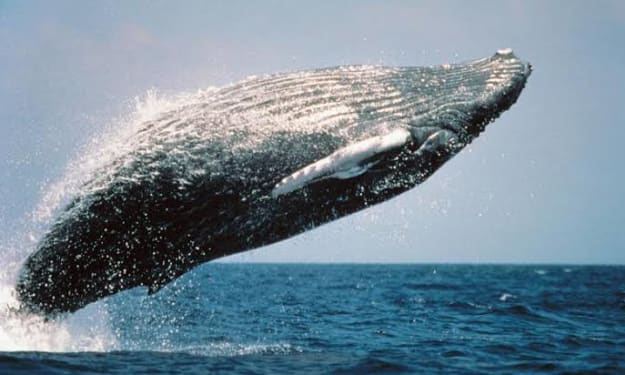Moving Forward with Sharks
(Un)common Knowledge About Misunderstood Creatures

What’s scarier than an ocean with sharks? An ocean without them. Greenpeace
During distance learning for elementary students this year, I incorporated a Would you Rather question as an ice-breaker for the start of each class. Soon, a pattern in the student’s choices emerged. Every time there was an option involving water, the students preferred the land activity, and I became curious.
“Alex, why did you pick hang-gliding over sail-boating?”
“Roxanna, why did you pick hiking in a forest over playing on the beach?”
Their reason was always the same: sharks.
As a positive response to their overwhelming fear of the creature, I decided to create an entire lesson around Lily William’s If Sharks Disappeared? This book teaches that even though sharks can be scary, they are integral in keeping oceans healthy. It explores how shark extinction would affect other animals across the whole planet, eventually affecting humans.
I spent my childhood summers on the beach, where adults hid their faces behind paperback copies of Jaws. Yes, the iconic cover was terrifying, but we didn’t allow the extremely unlikely chance of a shark encounter ruin our days splashing in the ocean. In fact, we would grab each other’s legs under the water, or imitate the famous dun-dun, dun-dun theme song.

Of course, it’s natural for my students and others to be fearful of sharks. My concern is that their fear will prevent them from learning about these creatures and lead to indifferent attitudes about their protection. There are only five to ten shark-related deaths a year, while a hundred million sharks are killed by humans every year. We demonize sharks as being sharp-toothed predators and ignore their role in keeping the ocean healthy.
We should be afraid of sharks half as much as sharks should be afraid of us. –Peter Benchley, author of Jaws.
Try to wring that haunting melody from your mind, and let’s explore some (un)common facts about the misunderstood shark.
Did you know that more people die from taking selfies than from shark attacks?
In 2018, the Journal of Family Medicine and Primary Care found that 259 people worldwide died in 137 selfie-related accidents between 2011 and 2017, compared to just 50 people killed by sharks. And the number of deaths while posing for the perfect shot are rising each year. Drowning, transportation accidents, and falls were the most common reasons for deaths by selfie. So, at over five times more deadly than sharks, perhaps the smartphone should have its own killer theme song.
You think dinosaurs are old? Sharks first appeared over 400 million years ago - even before dinosaurs.
Hasn’t anyone told you to respect your elders?
According to Josh Davis, a writer for the Natural History Museum in London, sharks appeared during the Late Ordovician Period, evidenced by the oldest known shark scales found in Siberian deposits. This means that these adaptable creatures have survived the “big five” mass extinctions, making them older than trees and dinosaurs. Let’s hope that sharks will be able to adapt yet again in the face of the human-caused sixth mass extinction due to wildlife trade, pollution, habitat loss, and toxic substance use.
Did you know that sharks and trees have a lot in common?
Scientists can determine the growth of a shark based on the number of bands around its vertebrae, just as they identify a tree’s age by the rings in its trunk. According to marine biologist Dr. David Shiffman, the “[r]ing patterns come from seasonal changes in resource availability, which leads to seasonal changes in growth patterns and a series of annual rings.” Scientists have found that sharks in the wild can live a long life. Great white sharks average 70 years, while whale sharks can survive 100 years. That is nothing compared to the Greenland shark that may be able to live over 500 years. According to Encyclopedia Britannica editor John P. Rafferty, it is longest-living vertebrate known. Now isn’t that something worth saving?
Cheetahs and zebras aren’t the only animals covered in a special pattern.
Each whale shark has its own pattern of white spots that is as unique as a human fingerprint. According to Oceana, “whale shark researchers utilize specialized computer software, originally designed for star mapping, to identify individual whale sharks from photos of their spot patterns.” This technology helps researchers track the movement of individual whale sharks.

Whale sharks are also the largest sharks in the world. About the size of a school bus, they can be sixty feet long. Amazingly, they eat only small things such as shrimp and algae.
Sharks give cheetahs a literal run for their money.
Attention, car enthusiasts! Did you know that a shortfin mako shark can accelerate faster than a Porsche? It has a streamlined, torpedo-shaped body to minimize drag and reach bursts of up to 60 miles per hour. But, the species is trying to race its way out of a vulnerable position. They are facing a high risk of extinction in the wild.
The salmon shark can swim up to 55 miles per hour, making it the second fastest. They too have a tapered, streamlined body that reduces the drag as it cruises through the water.
Most sharks will sink and die if they stop swimming.
Dory’s popular catchphrase from Finding Nemo, “just keep swimming,” is a lifesaver for sharks such as the great white and mako. All sharks convert water into oxygen to breathe, but many sharks can’t pump water over their gills. So to stay alive, they have to constantly swim forward to keep water filtering through their gills.
According to the American Museum of Natural History, the shark’s lack of a swim bladder (a gas-filled sac inside many bony fishes used to maintain and control buoyancy) allows them “to move between different depths without the risk of exploding or imploding.” Swim bladders are the reason why other fish risk their lives if they go too shallow or deep in the water.
This shark’s unusually-shaped head has a purpose.
The hammerhead shark’s unusually-shaped head and wide set eyes provides them with 360-degree vision, a much better visual range than other sharks. Their wide-set eyes give them a better visual range than most other sharks. They also have a group of sensory organs, the ampullae of Lorenzini, which enables them to detect the electrical fields created by prey animals. According to National Geographic, “the hammerhead's increased ampullae sensitivity allows it to find its favorite meal, stingrays, which usually bury themselves under the sand.”
Sharks are essential for the health of the ocean.
Without sharks, you take away the apex predator of the ocean, and you destroy the entire food chain. Peter Benchley, author of Jaws
In their role as a top predator, sharks remove prey animals that are sick or weak, ultimately allowing those species to grow stronger and the oceans to become healthier and more diverse. Humane Society International (HSI) states that “[h]ealthy numbers of sharks are an indicator of the health of our marine environment, with research demonstrating that the massive depletion of sharks that has occurred in the marine environment worldwide has had negative and cascading effects throughout our ocean ecosystems.”
"Sharks are beautiful animals, and if you are lucky enough to see them, that means you are in a healthy ocean. You should be afraid if you are in the ocean and don’t see sharks." Sylvia Earle, marine biologist
Humans are on the way to causing the extinction of many shark species. Believe it or not, the loss of sharks would cause the disappearance of coral reefs and sea grass. Without sharks, lower species on the food chain would grow too populous and overeat ocean vegetation.
So in essence, by saving sharks, we are saving ourselves and our planet.
If man doesn't learn to treat the oceans and the rain forest with respect, man will become extinct. – Peter Benchley, author of Jaws
Sharks are essential for tourism as people visit oceans to dive and swim with them.
Sharks are among divers’ list of top animals to see, meaning they are worth much more to the tourism industry, where people repeatedly pay to interact with them, than they are to the fishing industry, where they can only be sold once. When my husband and I were in Belize, we were one of those tourists. Even though I’m sure my pulse rate increased, snorkeling with Nurse sharks was one of the greatest and most unique experiences in my life. Seeing the graceful creatures glide along the sandy bottom of the sea was mesmerizing.


Shark Allies states, “The global shark diving industry generates $314 million per year, directly supporting 10,000 jobs. This is expected to double within the next 20 years, generating more than $780 million per year. By comparison, the landed value of global shark fisheries is currently $630 million and has been in decline for most of the past decade, mainly as a consequence of overfishing.” Sharks are worth more alive than dead.
Sharks populations are being decimated by the shark finning industry.
Sharks are at risk of extinction because fishermen cut off their fins and leave them to die in the water. These fins are used for the highly-coveted shark fin soup in Asia. According to the Humane Society of the United States (HSUS), up to 73 million sharks are killed for their fins every year. Many organizations, such as the Humane Society Legislative Fund (HSLF), are working towards strengthening the United States’ shark finning ban by prohibiting the possession, sale, and trade of shark fins. Only 13 states currently ban the sale of shark fins. Shark finning has been compared to having your limbs cut off and being left to drown.
In addition to shark finning, sharks are being culled, hunted for sport, and killed for meat and products such as teeth, leather, cosmetics, and “health” supplements. They are also inadvertently caught by commercial fisherman with different targets in mind. Habitat loss is another issue, caused by pollution, coastal development, mining, and aquaculture. The Humane Society of the United States (HSUS) estimates that nearly a quarter of all shark and ray species are threatened with extinction. Some organizations are working toward expanding sanctuaries where fishermen cannot catch or hunt sharks.
There are many ways that people can work towards shark conservation including volunteering and writing to federal lawmakers to close the loophole in the law that allows the United States to remain a hub for the possession, sale, and trade of shark fins. It is also important to make environmentally-friendly choices such as disposing of trash and recyclables wisely (including disposable masks).
However, changing attitudes may be what is needed the most. And that may start with a lesson given by me, an elementary school librarian. Peter Benchley said, “It's hard to care deeply for something that might turn on you and eat you.” But looking at the bigger picture, it is clear that sharks have an integral role in sustaining the place that we call home. And maybe that’s a good enough reason to care for them.
For more information, check out sites such as Humane Society of the United States, Humane Society International, Shark Allies, Oceana, Wildlife Conservation Society, Shark Alliance, Project AWARE, and Shark Trust.
About the Creator
Jennifer Christiansen
Animal advocate, traveler, and bibliophile. Lover of all things dark and romantic.
Reader insights
Outstanding
Excellent work. Looking forward to reading more!
Top insights
Eye opening
Niche topic & fresh perspectives
Easy to read and follow
Well-structured & engaging content
Excellent storytelling
Original narrative & well developed characters
Expert insights and opinions
Arguments were carefully researched and presented
Heartfelt and relatable
The story invoked strong personal emotions
On-point and relevant
Writing reflected the title & theme






Comments (2)
Loved this article!
Nice! Very informative!